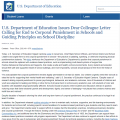School discipline refers to the rules and strategies applied in school to manage student behavior and practices used to encourage self-discipline.
School discipline addresses schoolwide, classroom, and individual student needs through broad prevention, targeted intervention, and development of self-discipline. Approaches to school discipline range from restorative (e.g., schoolwide school climate improvements, use of restorative practices) to punitive (e.g., suspension, expulsion, corporal punishment). When considering approaches to school discipline, the social discipline window is a conceptual model that provides way to maintain social norms and behavioral boundaries while defining restorative practices as a leadership model for parents in families, teachers in classrooms, and administrators in organizations. How school discipline is handled has a great impact on the learning environments of schools.
Students who have been suspended are significantly more likely to drop out of school and become involved in the juvenile justice system than their peers. Students of color, especially boys, and students with disabilities are disproportionately punished. Suspensions are often subjectively applied in such cases. For example, a significant percent of suspensions and expulsions are for trivial or minor offenses (e.g., "being disrespectful" or violating school dress code). Schools that approach school discipline punitively affect the overall school climate, creating a more negative environment for all students, including those without discipline issues.
Establishing and maintaining a positive school and classroom climate allows a school community to proactively prevent discipline issues by increasing the strength and the quality of classroom activities. Implicit in this approach is the assumption that participating in well-managed classroom activities encourages self-discipline by teaching students about what is possible through cooperation and coordination with others. It also provides the essential conditions for caring, support, clear expectations, and guidance that nurture healthy student development and motivation. Additionally, fostering a sense of belonging can reduce disciplinary issues. Youth feel emotionally and physically safer in schools that have a fair school disciplinary structure, which has been linked with reductions in depressive symptoms, anxiety, and conduct problems.
A positive approach to discipline shifts the focus of discipline from punishment to restoration of relationships and restored understanding of and commitment to building a safe and supportive environment. The purpose of discipline then becomes the teaching of civility and interpersonal skills and the reconnection of alienated children. Preventive methods and multi-tiered models can provide pre-planned responses to disruption/violence, laying the foundation for positive discipline methods to be successful in creating a safe school and the appropriate conditions for teachers to instruct effectively and for students to learn.
American Academy of Pediatrics. (1998). Guidance for effective discipline.Pediatrics, 101, 723–728.
Dishion, T. J., & Dodge, K. A. (2005). Peer contagion in interventions for children and adolescents: Moving towards an understanding of the ecology and dynamics of change. Journal of Abnormal Psychology, 33, 395–400.
Dishion, T. J., Dodge, K. A., & Lansford, J. E. (2006). Findings and recommendations: A blueprint to minimize deviant peer influence in youth interventions and programs. In K. A. Dodge, T. J. Dishion, & J. E. Lansford (Eds.), Deviant peer influences in programs for youth: Problems and solutions (pp. 366–394). New York: Guilford.
Fabelo, T., Thompson, M. D., Plotkin, M., Carmichael, D., Marchbanks, M. P., & Booth E. A. (2011). Breaking Schools' Rules: A Statewide Study of How School Discipline Relates to Students' Success and Juvenile Justice Involvement (Lexington, KY: Council of State Governments; College Station, TX: Public Policy Research Institute).
Gee, K. A., Haghighat, M. D., Vang, T. M., & Cooc, N. (2021). In the Aftermath of School Victimization: Links Between Authoritative School Climate and Adolescents’ Perceptions of the Negative Effects of Bullying Victimization. Journal of youth and adolescence, 1-14.
Gottfredson, G., Gottfredson, D., Payne, A., & Gottfredson, N. (2005). School climate predictors of school disorder: Results from a national study of delinquency prevention in schools. Journal of Research in Crime and Delinquency, 42, 412–444.
Goyer, J. P., Cohen, G. L., Cook, J. E., Master, A., Apfel, N., Lee, W., Henderson, A.G., Reeves, S.L., Okonofua, J.A., Walton, G. M. (2019). Targeted identity-safety interventions cause lasting reductions in discipline citations among negatively stereotyped boys. Journal of Personality and Social Psychology.
Gregory, A., Skiba, R. J., & Noguera, P. A. (2010). The achievement gap and the discipline gap: Two sides of the same coin? Educational Researcher, 39, 59–68.
Losen, D. J., & Whitaker, A. (11). million days lost: Race, discipline, and safety at US public schools (Part 1). Center for Civil Rights Remedies of UCLA’s Civil Rights Project and the American Civil Liberties Union of Southern California.
Mayer, G. R. (1995). Preventing antisocial behavior in the schools. Journal of Applied Behavior Analysis, 28, 467–478.
Mayer, G. R., & Butterworth, T. (1995). A preventive approach to school violence and vandalism: An experimental study. Personnel and Guidance Journal, 57(9), 436–441.
Morrison, G. M., Anthony, S., Storino, M. H., Cheng, J., Furlong, M. J., & Morrison, R. L. (2001). School expulsion as a process and an event: Before and after effects on children at-risk for school discipline. In R. Skiba & G. Noam (Eds.), New directions for youth development (pp. 45–71). San Francisco: Jossey-Bass.
Osher, D., Bear, G., Sprague, J., & Doyle, W. (2010). How we can improve school discipline. Educational Researcher, 39(1), 48-58.
Skiba, R., & Horner, R. (2011). Race is not neutral: A National investigation of African American and Latino disproportionality in school discipline. School Psychology Review, 40, 85-107.
Skiba, R. J., Michael, R., Nardo, A., & Peterson, R. (2000). The color of discipline: Gender and racial disparities in school punishment. Bloomington: Indiana Education Policy Center.
Skiba, R. J., Peterson, R. L., & Williams, T. (1997). Office referrals and suspension: Disciplinary intervention in middle schools. Education and Treatment of Children, 20, 1–21.
US Department of Education (ED). (2016, July 11). School Climate and Discipline: Know the Data. Laws & Guidance. Available at https://www2.ed.gov/policy/gen/guid/school-discipline/data.htm
Wachtel, T., (2016) Defining Restorative. International Institute for Restorative Practices, Available at https://www.iirp.edu/defining-restorative/social-discipline-window.



